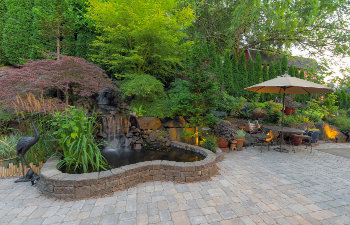
One of the critical aspects of our landscaping services at Woodburn Landscapes is the maintenance and enhancement of retention ponds. Here’s a closer look at the importance of retention pond maintenance and how skilled landscaping can utilize plantings to control erosion and improve the overall health of these vital water management features.
The Importance of Retention Pond Maintenance
Retention ponds are a crucial part of stormwater management systems, designed to control and regulate water runoff. They serve multiple purposes, such as preventing flooding, managing water quality, and protecting downstream ecosystems. Proper maintenance is essential to ensure these ponds function effectively. Here are some reasons why retention pond maintenance is vital:
- Preventing Erosion: Over time, the banks of retention ponds can erode, compromising their structural integrity and water-holding capacity. Neglected ponds may suffer from erosion that threatens the surrounding landscape.
- Water Quality: Retention ponds are designed to filter and cleanse stormwater runoff. Regular maintenance ensures that they continue to trap and remove pollutants, improving water quality before it enters natural water bodies.
- Aesthetic Appeal: A well-maintained retention pond enhances the overall aesthetics of a property or community. It can be a focal point for landscaping, providing a serene and attractive environment.
- Wildlife Habitat: Healthy retention ponds can support a variety of wildlife. Maintenance efforts can ensure that these ecosystems remain thriving and diverse.
Plantings for Erosion Control
One of the most effective ways to combat erosion around retention ponds is through strategic plantings. Here’s how a skilled landscaper can use plants to control erosion:
- Grass: Grasses with deep, fibrous root systems are excellent choices for stabilizing the soil around retention ponds. They anchor the soil, reducing erosion caused by water runoff.
- Native Plants: Native plants are well-suited to the local climate and soil conditions. They tend to have extensive root systems and can help prevent erosion while attracting native wildlife.
- Riprap Alternatives: In some cases, landscapers may recommend plant-based alternatives to traditional riprap (rocks or concrete blocks). These “bioengineering” techniques use a combination of plantings, root systems, and erosion-control fabrics to stabilize shorelines.
- Wetland Plantings: For retention ponds designed as wetlands, the selection of appropriate wetland plants is crucial. These plants not only prevent erosion but also help maintain the pond’s ecosystem balance.
- Revegetation: After erosion has occurred, revegetation efforts can help restore the area around the pond. This typically involves planting a mix of grasses, shrubs, and trees to stabilize the soil and promote healthy growth.
Landscaping plays a pivotal role in enhancing the health and functionality of retention ponds. When properly designed and maintained, a landscaped retention pond offers several benefits towards its health, function and aesthetics.
Need Retention Pond Maintenance Near Atlanta?
At Woodburn Landscapes in Alpharetta, we understand the intricate balance between aesthetics and functionality in landscaping. If you have a retention pond in need of maintenance or want to enhance its ecological and visual appeal, contact us today. Our skilled team can design and implement a landscaping plan tailored to your unique needs, ensuring that your retention pond remains an asset to your property and the surrounding environment.
Posted on behalf of
2090 Dunwoody Club Dr, STE 106-110
Atlanta, GA 30350
Phone: (678) 551-0916
Hours
Monday - Friday
8:30am - 5:30pm




